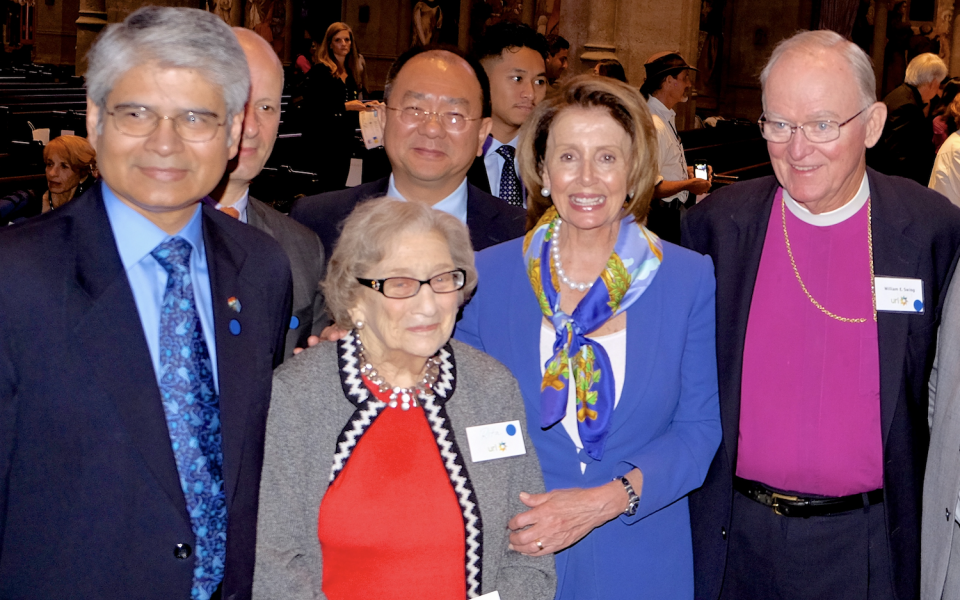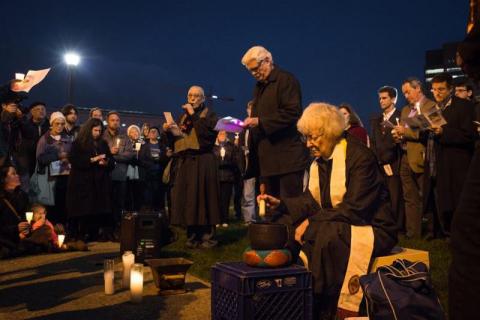Let me tell you about “the Rita Semel moment” when interfaith in the world and in San Francisco changed forever.

Ambassador Asoke Kumar Mukerji, Sam Chan, The Honorable Nancy Pelosi, and Bishop William Swing with Rita Semel
When I arrived in San Francisco in 1979, this is what interfaith work looked like. Occasionally, about 10 religious leaders gathered to speak out on crucial civic matters. That was it! 42 years later, here is what interfaith work looks like today. A vibrant San Francisco Interfaith Council with representatives of 800 congregations and religious institutions serving the vital needs of the community on a daily basis - working closely with City Hall. What happened between 1979 and 2021?
I would be right to say that the unity which abides in the heart of the Divine was manifested here. I would be right to say that thousands of people came together to forge the most dynamic interfaith city in the world. Also, I would be right to say…Rita Semel. Let me tell you about “the Rita Semel moment” when interfaith in the world and in San Francisco changed forever.
It was June 26, 1995, on the brand new steps of Grace Cathedral. Princess Margaret was there, as was the Secretary General of the United Nations, Kofi Anan, as well as Lech Walesa of Poland and a host of other notables. Waters from sacred water sources around the world were joined to anoint the brand new fountain of Grace Cathedral. Fresh off an Interfaith Youth Conference, youth from around the Globe were there. Religious leaders like Archbishop Desmond Tutu, Rabbi David Saperstein, W. Dean Muhammed, a Supreme Court Justice from Pakistan, Javid Iqbal, Nobel Prize winner, Betty Williams, and others had come together to prime the interfaith youth expectations for this day.
Believe me, our little interfaith group in San Francisco was punching far above our weight on that glorious day. We wanted something big to happen, bigger than the UN’s 50th Anniversary! And when it was all over, Rita Semel came up to me on the steps of Grace Cathedral and said, “We can’t stop here.”
We can’t stop here. That was “the Rita Semel moment.”
Ah, the genesis moment! Do we: 1) bask in this occasion of glory and retire to brag about it or 2) do we make this the first step in a far, far greater journey? What we did was to meet in my living room a couple of days later, six unlikely people – one of us was a short order cook – to start the long march toward interfaith’s improbable destiny in San Francisco and around the world. Rita’s words: “We can’t stop here,” carried the day.
Fast forward – Rita began working with the little group of interfaith folks housing homeless for the winter, and they ultimately became the San Francisco Interfaith Council. At the same time, Rita became the Interim Chair and then she became the first Chair of the Global Council of the United Religions Initiative – which incidentally became the world’s largest international interfaith organization. Something special happened in those days in this city. Rita Semel was percolating in the midst of it all.
It was as if she picked up her shovel – like the fabled John Henry – and started digging into the base of a mountain of religious resistance until, at long last, an interfaith railroad found light at the end of the tunnel and the train came rambling through.
San Francisco became different in those early Rita days. How different? When something big happened to one of the faith/interfaith leaders, we didn’t just email congratulations. We celebrated at San Francisco’s finest restaurant, Kokkari, thanks to its owner, George Marcus. When one of our own, Archbishop William Levada, was elevated to Cardinal, 30 of us from different faiths went to Rome to cheer him on. Rita went to the women’s room in a Roman restaurant, and a lady from Boston said, “30 of you from different religions? My goodness, that would never happen in Boston.”
I recently received a list of Rita’s wide ranging works in San Francisco. Oh my, such an over-the-top list! The testament of her labors lives in the fabric of scores of local institutions. But also, I am here to say that at the same time, Rita was presiding at the signing of the URI Charter in Pittsburgh, presiding a URI’s first Global Assembly in Rio de Janeiro, presiding at the URI Global Council Meeting in Seoul, Korea. She modeled – for the world – what an international interfaith executive should be like.
Going backwards for a moment, when did Rita get started down this road? The year was 1945. World War II had ended, and Rita and her husband, Max, settled in the congregation of Temple Emanu-El. The new Rabbi, Alvin Fine, asked Rita to be on the newly organized Social Justice Committee. She never looked back.
A couple of weeks ago, I caught Rita off guard by asking, “Why?’ “What motivated you to do all of this?” She was surprised by such a question.
But then her first response was, “It never occurred to me not to do it.”
Her second response: “I’ve always believed that all of us have more in common than we have differences.”
Her third response: “I’ve always adhered to “tikkun olam,” repairing the world. I wanted to repair the world as an amateur.”
So here we are, Rita, on your 100th birthday. Whew! Now I will finish with three things. 1) To the congregation, I want to point out that Rita’s father was in vaudeville. 2) Rita, I want to say that Mary Swing and I cherish and love you and feel so honored to be on this journey with you. 3) Finally, to anyone who will listen to the message of peace among the faithful of all faiths, remember Rita’s words, “We can’t stop here.”
Thank you!
